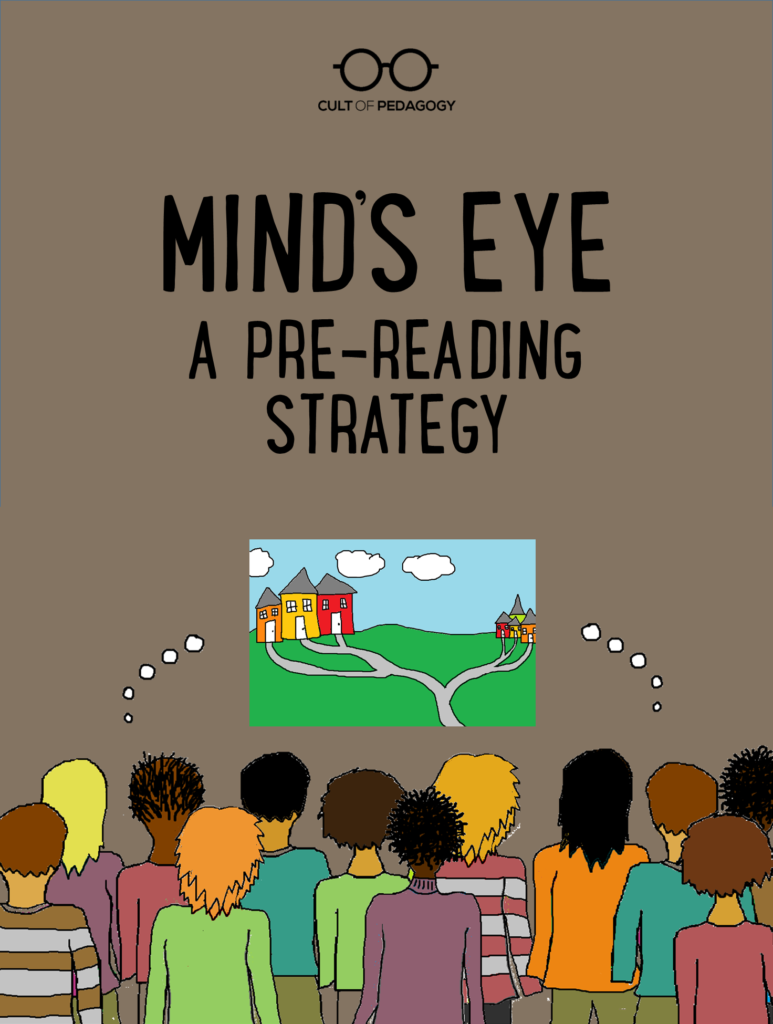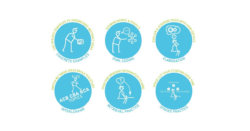
This pre-reading lesson is EASY to prepare and results in a richer text experience for students.
Some texts are just hard for students to get into. A certain book, article or chapter might contain the most incredible details, things that would make strong, long-lasting impressions on your students, but if they can’t sink their teeth in from the beginning, they may never get to those details.
The Mind’s Eye strategy tackles that problem head on: It grabs students’ attention before they ever read a single word and creates a mystery that can only be solved by reading the text.
Very briefly, the strategy goes like this: The teacher chooses 20-30 important words from the text. Before students do any reading at all, the teacher reads the words aloud to students — slowly, pausing in between words. As they listen, students form mental pictures, predicting what the text will be about. Then they read the text and compare it to their predictions.
Here’s the strategy in more detail:
The Research
This strategy is based on the principle of dual coding, the idea that people learn better when they process information through multiple channels — both language and images. It’s the same idea behind nonlinguistic representation, which we talked about in a previous post. Readers who construct mental images as they read do a better job of making meaning, but that skill doesn’t have to come along through luck; it can be taught. The Mind’s Eye strategy is one way to do that.
Good for Many Ages, Many Content Areas
Mind’s Eye can be used to prepare students for reading all kinds of texts. It would certainly work for challenging literature in the older grades, but also to prime younger students who are just starting to read chapter books. It would work beautifully at the start of a social studies unit or before students delve into a science article. As new standards place more emphasis on non-fiction and informational reading, a strategy like Mind’s Eye can help students experience these less “entertaining” texts more fully.
Where to Find Other Strategies Like This
Mind’s Eye is one of twenty research-based strategies outlined in Silver, Strong, and Perini’s excellent book, The Strategic Teacher: Selecting the Right Research-Based Strategy for Every Lesson
. [Note: This is an Amazon Affiliate link: If you go to Amazon through this link, I will receive a small commission on that purchase.] The Mind’s Eye chapter also describes three variations on this strategy — one that even shows how to use it with math. We have already studied two other strategies from this book: Concept Attainment and Reciprocal Learning. Because the book is such a solid collection, we’ll continue to explore more over time. For now, if you’re looking for something easy and fresh, give Mind’s Eye a try. ♦
If this one spoke to you, I’d love to have you come back for more. Join my mailing list and get weekly tips, tools, and inspiration — in quick, bite-sized packages — all geared toward making your teaching more effective and joyful. To thank you, I’ll send you a free copy of my new e-booklet, 20 Ways to Cut Your Grading Time in Half. I look forward to getting to know you better!






What do you think about combining this strategy with use of a Wordle?
Hey Melissa, this is Debbie, a Customer Experience Manager with CoP. We’re thinking Wordle could be used as a 2nd step with The Mind’s Eye Strategy. You do want to make sure you first go through the process of doing all the dramatic reading with no visuals, so kids can slowly incorporate each word into their mental picture. Without this first step, the impact of the strategy could potentially be ruined. Then as your Step 2, while kids are working on their end product, you could reveal the Wordle. That way when the words pop up during reading they’ll be easily recognized and connections will be made. Good luck…let us know how it goes!
Mind’s Eye teaching strategy… I really liked this strategy. I teach upper-level foreign language classes and many times the students are just not interested in the reading selection that I have planned for the class or the unit. I tried this strategy the other day. I carefully chose words to get their attention & I also made sure the words were known to the students so that everyone could follow along during this pre-reading activity. The list of words that I chose also doubled as a short & extremely basic summary of the entire selection. I really do feel that more students felt that they understood what they read due to this activity – and it didn’t take long to prepare.
Love this simple strategy. I can’t wait to use it and think it will really help students who have processing issues!
After watching the video and reading this post, I think this is a great pre-reading strategy. I think it is a great way to build interest and excitement about a text. However, I do wonder how this strategy would work with students that have limited background knowledge. About a third of my students have very limited background knowledge and vocabulary. Would I only be able to use this strategy in small group instruction with the students that have the appropriate foundational knowledge?
Hi Jennifer, Thank you so much for your informative and stimulating suggestions for teaching. I teach English as a foreign language in an Australian university college to pre-intermediate adult students on a pathway to university. I have used a technique which is similar to ‘Mind’s eye’ with my students which I’d like to share with you and your readers. (Adapted from “Teaching and developing reading skills”, Peter Watkins, Cambridge, 2017; a great resource book). I give the students a list of important words from the text and ask them to discuss, in pairs, synonyms and other associated words, and any emotions they associate with the words. Finally I ask them to predict what the text might be about, then they read to check their predictions. Vocabulary is a huge issue with English language students, but this activity gives them time to process the vocabulary before reading, as well as develop mental images of the content. Happy teaching.
Hello Jennifer,
Just wanted to leave a quick comment regarding this mind’s-eye strategy. I understand that this can be a very useful strategy for the majority of students, however, some consideration should be made for those who may have aphantasia (the inability to imagine, or a lack of mind’s-eye). It is a condition that has come to light in recent years, and research has shown that as much as 2% of the population may have this. Just wondering if there are any alternatives you could suggest for those students who will not get the benefit of this exercise?
Thanks,
Laura
Hi Laura,
Thanks for bringing this up – aphantasia isn’t something I’m really familiar with or have explored. I’m just wondering if it would work to provide a student with some pictures rather than asking them to visualize the set of words. An inductive learning lesson might also be an alternative. I’m hoping others will see your question and be able to jump in with ideas.
“Dago” is not a word that should be read to students in this manner. It is an ethnic slur. Please rethink its inclusion.
Hi Jen, Thanks so much for pointing this out. I made this video such a long time ago that I had to rewatch it to find where the word was. It comes from a story of a family emigrating to the U.S. from Italy, and they experienced discrimination upon arrival. I am going to look into what I can do to edit this out. Thanks again.
Thank you for your response and attention. It is appreciated.